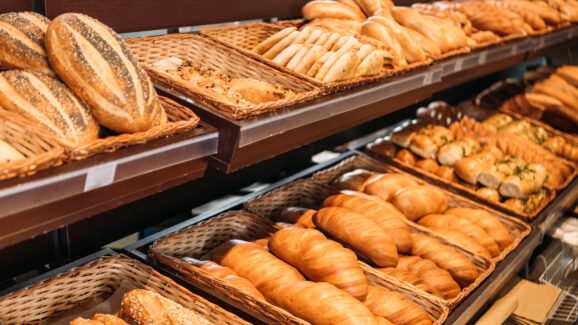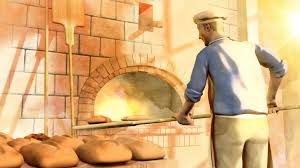The Bread Market!

- >
- Teachers
- >
- Teacher Resources
- >
- Lesson Plans
- >
- Stand-Alone Lessons, Activities & Hot Topics
- >
- The Bread Market!
 Download Bread Market Teacher Guide, Handouts and Visuals doc file (or pdf).
Download Bread Market Teacher Guide, Handouts and Visuals doc file (or pdf).
An emergent order activity to accompany the poem and video “It’s a Wonderful Loaf,” by Russ Roberts.
LESSON DESCRIPTION:
Emergent order is the term used in economics to describe an orderly outcome that emerges, not by design or intent, rather it emerges spontaneously from the actions of individuals and their voluntary interactions with others while pursuing their own self-interest. This lesson simulates a bread market that undergoes an unpredicted shock and the emergent order that follows. Students, acting as buyers and sellers participate in a couple rounds where they come to learn about the market and develop some expectations about the price. Then, unbeknownst to buyers and sellers a demand shock occurs. Knowing only their own willingness to buy or sell and their past predictions about price, students play an additional round where they witness and experience how without any coordination or direction the market adjusts to the increased scarcity.
This lesson was written to accompany the poem and video, “It’s a Wonderful Loaf” by Russ Roberts available at www.wonderfulloaf.org.
VOLUNTARY NATIONAL CONTENT STANDARDS IN ECONOMICS
Standard 8: The Price System
Prices send signals and provide incentives to buyers and sellers. When supply or demand changes, market prices adjust, affecting incentives.
- High prices for a good or service provide incentives for buyers to purchase less of that good or service and for producers to make or sell more of it.
- Lower prices for a good or service provide incentives for buyers to purchase more of that good or service and for producers to make or sell less of it
TIME REQUIRED: 1 class period
MATERIALS:
- Visual 1: Transaction Tally Sheet
- Handout 1: Buyer cards, 22 copies (cut up to make 128 buyer cards)
- Handout 2: Bread cards, 8 copies (cut up to make 90 cards)
- Handout 3: Seller role cards, 1 copy (cut up to make 6 cards)
- Handout 4: Buyer transaction record – 1 per student minus 6
- Handout 5: Seller transaction record -12 copies
- Handout 6: How to Play – 1 per student (consider copying onto the backside of the buyer and seller transaction records, Handouts 4 & 5)
- Handout 7: Willingness to Pay – 1 copy (on cardstock)
- Handout 8: Willingness to Sell – 1 copy (on cardstock)
- Handout 9: Assessment – 1 per student
- Candy or other prizes to be purchased with “profits”
- “It’s a Wonderful Loaf” video and poem available online: wonderfulloaf.org
PREPARATION:
- Make 128 buyer cards on a single color of card stock paper. Prepare 64 low buyer cards and 64 high buyer cards according to the following distribution.
| Buyer Cards
Low Value |
Buyer Cards High Value |
||
| Buy Value | No. of cards | Buyer Value | No. of cards |
| $2.50 | 4 | $4.20 | 4 |
| $2.70 | 4 | $4.50 | 4 |
| $2.90 | 4 | $4.80 | 4 |
| $3.10 | 4 | $5.10 | 4 |
| $3.30 | 8 | $5.40 | 8 |
| $3.50 | 8 | $5.70 | 8 |
| $3.70 | 12 | $6.00 | 12 |
| $3.90 | 12 | $6.30 | 12 |
| $4.10 | 8 | $6.60 | 8 |
- Keep the two decks, high cards and low cards, separate. Mark the higher deck with a small mark or dot on the back side of each card that will go unnoticed by students but allow for easy sorting, should cards from the two decks get mixed.
- Create a tally sheet on the board or project VISUAL 1 included in this lesson.
PROCEDURE:
- Explain to students that they are going to take part in a market simulation.
- Select 6 students to be sellers of bread and give each seller two copies of the seller transaction record (HANDOUT 5), a seller role card (HANDOUT 3), 10 loaves of bread (HANDOUT 2), and “How to Play” (HANDOUT 6). Instruct them to begin reading the seller instructions on the “How to Play” handout. (Don’t announce how many bread cards they get.)
- The remaining students will all be buyers. Give each buyer one low value buyer card (HANDOUT 1), a buyer transaction record (HANDOUT 4), and a copy of “How to Play” (HANDOUT 6). Instruct the buyers to read the buyer instructions in the “How to Play” handout.
- ADJUSTING FOR SMALLER CLASSES: If you have a smaller class (fewer than 25) you may want to reduce the number of sellers to 5. Never go below 4 sellers. It’s important to keep both sides of this market “competitive.” You can always make up for fewer buyers by letting the rounds go longer, which allows each buyer to conduct more transactions. Each time they get a new card, they are like a new buyer in the market.
- Keep the set of “high value” buyer cards out of sight. Place the remaining low value buyer cards face down on your table at the front of the room.
- While the buyers are reading their instructions, call the sellers to the front of the room and ask if they have any questions. Let them know that they all have the same cost of production for bread. Ask what kind of prices they have to get for bread to make a profit. (More than their cost of production.) Ask if they understand how to get more bread (per the instructions on their card) if they run out? Make sure they understand that the additional bread comes at a higher cost, so they would only want to go to the extra trouble to make more bread if they can sell it at a price high enough to cover the additional cost. Let the sellers return to their seats.
- Prepare students to play the game.
- Ask the buyers what kind of prices they would like for bread. (Low prices!)
- Ask the sellers what kind of prices they would like for their bread. (High prices!)
- OPTIONAL: If this is the first market game your students have played or if you have students that would benefit from a visual example of the negotiations that will happen during the game, conduct this demonstration. Have a buyer and seller stand in the front of the room. Give the buyer HANDOUT 7: “Willingness to Pay.” Have them hold it up and show the class, but not the seller. Give the seller HANDOUT 8 “Willingness to Sell.” Have them hold it up and show the class, but not the buyer. Instruct the buyer and seller to negotiate and come to an agreement on a price to purchase the bread. Help or prompt the students if needed.
- Make sure the students understand that buyers like the lowest price possible but are willing to pay up to the amount on their card. A higher price than that means it’s not worth it to them.
- Likewise make sure they understand that sellers like the highest prices possible but will sell for as little as their cost of production (price on card). A lower price than their cost of production means they lose money and it’s not worth it to sell.
- Emphasize that buyers must exchange the loaf of bread they purchased AND their buyer card in order to get a new buyer card and do another transaction in the round. Encourage students to make as many transactions as they can in the time permitted.
- Make sure both buyers and sellers understand how to calculate their “profit” (sellers) or “gain” (buyers) on their score sheets. Announce an incentive – that students will be able to spend their profits/gains on candy at the end of the game.
- Clear the center of the room, and set up 6 “stores” around the perimeter to create a marketplace. Send the sellers to their stores.
- Explain that you will conduct a number of rounds of trading sessions of approximately the same length.
ROUND 1
- Open round 1. Monitor the market and end the round before the sellers have time to run out of bread or as soon as you notice someone runs out. (Expect some confusion, especially if students have not played market games before. Also expect that they will sort out the process and transactions will be made. You may wish to play the first round as practice, and “start over” after it appears that most students have figured out their roles.)
- Give students time to figure their net losses and gains — their “profit.” Display Visual 1: Tally Sheet. Ask each seller to report the number of loaves they sold and record it on the tally sheet. Ask the sellers to estimate the average price of bread they sold and ask buyers what they think the average price was. Come to a consensus and record an “average price” for the round.
- Collect all buyer cards and any loaves of bread.
- Distribute the bread cards so that each seller again has 10 to start the round.
- Give all buyers a new low value buyer card.
ROUND 2
- Play a second round with low buyer values so buyers and sellers form some expectations about price.
- Call an end to the second round before the buyers have a chance to run out of bread. Collect all outstanding buyer cards and loaves of bread. While students are calculating their gains, swap the low value buyer deck for the high value buyer deck.
- Record the total number of loaves sold in round 2 as well as an “average” price for bread that round on the tally sheet.
- Once again, replenish the sellers inventory of bread so they have 10 to start the round.
- Give all buyers a high value buyer card. IMPORTANT: Do not draw attention to the fact that you are using a different buyer deck for the next round. It’s important that each buyer only know that they are willing to pay more… not that all buyers in the room are willing to pay more. Likewise, sellers only know from past experience what buyers are generally willing to pay.
ROUND 3
- Open the market for round 3. (Expect buyers to be willing to pay more and sellers to quickly figure out that they can sell for higher prices. Sellers will sell out quickly and because of the higher price, decide to get more bread.) Let the round go long enough that several sellers have come to the front of the room and completed the required jumping jacks to get more bread. Remind them as you give them the 5 additional loaves that they have a higher cost of production. Some sellers may choose not to get more bread and some may return several times to get additional batches of bread.
- End the round. Allow time for profit calculations and then display the tally sheet. Call attention to the increased number of transactions and the higher average price.
DISCUSS:
- What was different in this round? (Price were higher. More bread was sold.)
- How might we explain this difference? Why might buyers have higher value for bread? (Anything that would increase demand would be an appropriate answer: increase in income, change in consumer tastes/preferences, increase in the price of a substitute, decrease in the price of a compliment, etc.)
- Why didn’t sellers do jumping jacks and get more bread to sell in the first 2 rounds? (The price buyers were willing to pay wasn’t high enough to cover the cost of the additional loaves.)
- Did sellers have to know what happened or why buyers demand for bread increased? ( They were just responding to the higher prices.)
- Did buyers have to know what all the other buyers were willing to pay and what it cost the sellers to produce bread, in order to make a decision about whether to buy bread or not? ( All they needed to know was the price of bread and what they were willing to pay.)
- Are buyers worse off because of the higher price for bread? ( They were paying less for bread than they were willing to pay, and they got even more bread in the last round. Ask for a few student buyers to share their total gains from each round. Most will have even greater gains in the last round.)
- Who set the higher price for bread in the last round? ( It emerged from the voluntary actions of buyers and sellers.)
- Point out that this is an example of emergent order. That without any coordination or design or person in charge, the participants in this market, each acting with just the little bit of information that they had, responded in a way that addressed the demand shock.
VIDEO:
Show the video “It’s a Wonderful Loaf” by Russ Roberts available on YouTube https://youtu.be/ODHBrCQdUy8 or at http://www.wonderfulloaf.org. Use the official text version of the video so students can read the poem during the animation.
DISCUSS:
The poem says:
So there must be a czar of wheat and flour, of trucks and of bread and yeast
To allocate and oversee and plan at the very least
For the unexpected change. What if today’s not like yesterday?
It never is though, is it? So who keeps the chaos away
How does the bread market activity you participated in, fit with this verse? Who (or what) kept chaos away? How did that happen?
ASSESSMENT:
Provide students with a copy of HANDOUT 9 (poem and related questions) and use one of the following strategies to formally or informally assess their learning.
- Have students watch the video again on their own and respond in writing to one or more of the questions.
- Divide students in small groups. Assign each group one of the questions to discuss. Have groups report out to the class as a whole. Solicit feedback and reactions from the rest of the class.
- Give them time in or out of class to respond to the questions. Have them share their answers first in a small group. Then conduct a discussion with the class as a whole.
Recent Blog Posts
View More
October is National Economic Education Month. We need it more than ever.
The Washington Examiner By Ted Tucker October 2, 2025 A fundamental economic principle is that voluntary trade creates wealth, and the…

FTE: Celebrating 50 Years of Excellence in Economic Education
April 23, 2025 2025 is a special year for the Foundation for Teaching Economics (FTE), as we celebrate our 50th…

The Economic Way of Thinking: The Key to Financial Literacy
April 10, 2025 Professor Jamie Wagner discusses how economics is the key to financial literacy. She is a Professor and…
